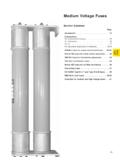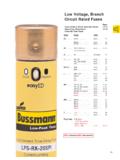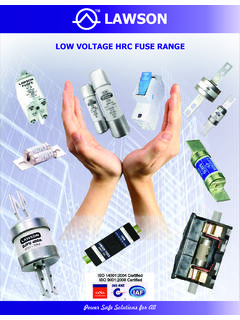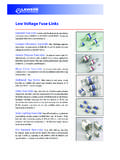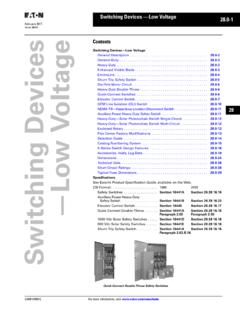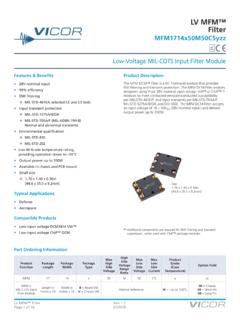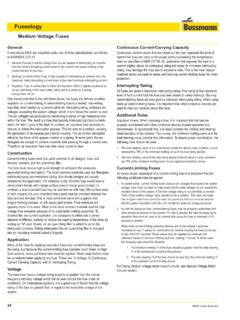Transcription of 18 Medium Voltage Fuses - eaton.com
1 Volume 12 Aftermarket, Renewal Parts and Life Extension SolutionsCA08100014E October Voltage FusesMedium Voltage Fuses18 Medium Voltage FusesProduct Description .. V12-T18-2 Product History .. V12-T18-2 Product History Time Line.. V12-T18-2 Product Application and Naming .. V12-T18-3 Current-Limiting Fuses .. V12-T18-4 Expulsion Fuses .. V12-T18-5 Product Selection .. V12-T18-6 Further Information .. V12-T18-8 Pricing Information .. V12-T18-8V12-T18-2 Volume 12 Aftermarket, Renewal Parts and Life Extension SolutionsCA08100014E October Voltage FusesCurrent-Limiting and Expulsion FusesCurrent-Limiting and Expulsion FusesOriginally a Westinghouse ProductMedium Voltage FusesProduct DescriptionEaton Medium Voltage Fuses offer such a range of characteristics that almost any fuse application, within the practical range of such interrupting devices, may be satisfied.
2 This range of characteristics is offeredin part by the production of both expulsion and current-limiting power and current-limiting Fuses provide such diverse characteristics by employing different areas of fuse technology. These differences in technology, along with the diverse characteristics, require that different questions be answered when applying expulsion and current-limiting HistoryThe eaton power fuse product line was introduced in the 1930s by Westinghouse Electric Corporation. As power systems grew in size, the need to sectionalize utility feeders and to protect equipment became apparent. The initial fuse development efforts resulted in the creation of non-current-limiting, expulsion type Fuses . As the available fault currents grew, the need for a current-limiting fuse was apparent and this resulted in new interruption basic fuse technology has not changed greatly over the years, gradual improvements have been made to make the Fuses more current-limiting and easier to manufacture and install.
3 Because standards for Fuses (ANSI C37) detail only test methods and basic performance requirements, many different varieties of Fuses (length, diameter, short-circuit interruption curves) have been introduced over the presently manufactures Medium Voltage Fuses in Haina, History Time LineGeneral InformationFuses in PerspectiveAdvantagesMedium Voltage fuse ComparisonNotes1 BAL superseded by superseded by Refills and holders only, new installations use Refills Superseded by BAL-R CLECLSCLPTCLTCX/CXNHLEBA DBA RBARDBDBS DBU V12-T18-4V12-T18-4V12-T18-4V12-T18-4V12- T18-4V12-T18-4 V12-T18-5V12-T18-5 V12-T18-5 Product 1935 1940 1945 1950 1955 1960 1965 1970 1975 1980 1985 1990 2000 PresentPageMediumVoltageCurrentLimitingE xpulsionBackupGeneralPurposeCutouts& OthersBoricAcidDistrbutionPowerPowerC RETV oltageTypeClassApplicationAmp RatingDistrbutionK EExpulsionCurrent-LimitingVentedSealedEl ectromechanicalStaticExpels gases/noiseNo gases/noiseInterrupts at natural current zeroLimits fault currentGenerally higher Voltage /current applicationsGenerally higher interrupting ratingsDifferences in time/current characteristicsDifferences in time/current characteristicsVolume 12 Aftermarket.
4 Renewal Parts and Life Extension SolutionsCA08100014E October Voltage FusesCurrent-Limiting and Expulsion FusesApplication Guide Guide to NamesBCLS Bolt-in version of CLS Bolt-in version of HLE Current-limiting Current-limiting E-rated, interchangeablewith General Electric and Gould Current-limiting interchangeable with McGraw-Edison s NX brand Fuses , Current-limiting transformer Current-limiting E-rated for potential Current-limiting for motor starters, Refillable boric acid expulsion fuse (indoor use).RDB Refillable dropout boric acid expulsion fuse (outdoor use).DBU Dropout boric acid fuse interchangeable with S&C s SMU-20 to Ampere Ratings E DesignationFuse rated 100E or below will melt in 300 seconds at a current value between and times the E rated above 100E will melt in 600 seconds at a current value between and times the E the current is higher than or times the E number, the user must consult the time-current curves for that particular fuse .
5 R DesignationThe fuse will melt in 15 to 35 seconds when the current equals 100 times the R the current is higher than 100 times the R number, the user must consult the time-current curves for that fuse . C DesignationThe fuse will melt in 1000 seconds at a current value, between and times the C the current is higher than times the C number, the user must consult the time-current curves for that particular fuse . A DesignationFuses that do not comply with E, R or C Fuses can also be E-rated, K-rated and T-rated, and are also covered in the ANSI standards. The K and T ratings refer, respectively, to relatively fast and slow melting expulsion Fuses . Detailed time-current tables adequately define these GuideRatingsFeederCircuitSection-alizing FusedSwitchesPowerTrans-formersSubstatio nServiceTrans-formersDIPPoleUndergroundD istributionTra n s f o r m e r sPole-MountedTr a n s -formersPad-MountedDistributionTra n s f o r m e r sMotorStartersPotentialTrans-formersSub- stationCapacitorBanksTypeClassUseBrandkV ,Ampere,kACurrentlimitingGeneralpurposeP owerBHLE/CLE/ kV10E 1350 Ato 85 kA 300C50 kA kV4A 150A25 kA 38 10 Eto 80 kA kV2R 36R 50 kA 720E 720E 38 kV5E 200E15SE 200SE 3K 200K V12-T18-4 Volume 12 Aftermarket.
6 Renewal Parts and Life Extension SolutionsCA08100014E October Voltage FusesCurrent-Limiting FusesCurrent-Limiting FusesCLE and HLE Current-Limiting E-RatedCLPT Current-Limiting E-Rated for Potential Transformer ProtectionCLS Current-Limiting for Motor StarterCX Current-Limiting Interchangeable with McGraw Edison s NX TypeCLT Current-Limitingfor Transformer ProtectionProduct DescriptionCurrent-limiting Fuses are constructed with pure silver fuse elements, a high-purity silica sand filler, a specially designed core and a glass resin outer high fault current melts the silver element almost instantly and loses energy to the surrounding sand. The sand melts and forms fulgurite, a glass-like arc Voltage rapidly increases to nearly three times the fuse Voltage rating and forces the current to zero. Low fault current melts a solder drop on the silver fuse element that, in turn, melts the element burns back until there is a sufficient internal gap to interrupt the current.
7 This is known as the current-limiting Fuses are offered in two basic types: backup and general purpose. Backup Fuses have a published minimum interrupting current and require a series device for breaking the circuit for currents below this minimum level. General purpose Fuses have improved low current interruption capability and are designed to interrupt low fault currents that cause the fuse to melt in one hour or InformationApplicationsCurrent-limiting technologies can be used to meet almost every fuse application. Typical applications for utility, industrial, construction and OEM customers include: Feeder circuit sectionalizing Power transformers Substation service transformers Underground distribution transformers Pole-mounted transformers Pad-mounted distribution transformers Fused switches DIP poles Motor starters Potential transformers Substation capacitor banksAccessoriesA wide assortment of mountings, live parts and end fittings are available to facilitate power fuse include a base, porcelain or glass polyester insulators and live parts.
8 They help enable the fuse to be safely attached to the gear. Mountings can be either disconnect or Parts attach the fuse to the mountings and are considered part of the mounting. All parts above the insulators are live PartsEnd Fittings are metal parts that attach to each end of the fuse at the ferrules. They are used only on disconnect Fuses or when converting a nondisconnect to a disconnect 12 Aftermarket, Renewal Parts and Life Extension SolutionsCA08100014E October Voltage FusesExpulsion FusesExpulsion FusesRBA Refillable Boric AcidRDB Refillable Dropout Boric AcidDBU Dropout Boric Acid Interchangeable with S&C s SMU-20 Product DescriptionEaton expulsion Fuses use boric acid as the interrupting Medium . Under a fault condition, arc heat decomposes the boric acid, which produces gases and boric anhydride. The water vapor blast extinguishes the arc in a deionizing action and exits from the bottom of the RBA indoor expulsion Fuses are fitted with a filter or condenser that moderates the discharge exhaust.
9 The discharge filter limits the exhaust to a small and relatively inert amount of gas and lowers the noise level without affecting the fuse interrupting rating. Steam discharge, that can affect the interrupting, is fully restricted by the type RDB outdoor dropout fuse includes an ejector pin that is forced through the top of the fuse . The ejector pin releases a latch on the mounting and the fuseholder is kicked outward and swings into the dropout position, through 180 with a vertical mounting, or 90 with an underslug units can be field installed into RBA and RDB expulsion Fuses . Once the old unit has been removed, the separately purchased unit can be easily installed into the fuse InformationApplicationsExpulsion technologies can be used to meet a number of fuse applications. Typical applications for utility, industrial construction and OEM customers include: Feeder circuit sectionalizing Fused switches Power transformers Substation service transformers DIP poles Potential transformers Substation capacitor banksAccessoriesThe following accessories are available for expulsion Fuses :Mountings include a base, porcelain or glass polyester insulators and live parts.
10 They help enable the fuse to be safely attached to the gear. Mountings can be either disconnect, nondisconnect or dropout. Fuses may be vertical or Parts attach the fuse to the mountings and are considered part of the mounting. All parts above the insulators are live Fittings must be mounted on DBU fuse units to enable them to be fitted into the and Condensers are for indoor applications of RBA expulsion Fuses . They confine the arc within the fuse and substantially reduce the noise and exhaust when the fuse are used with DBU Fuses in indoor applications to virtually eliminate offensive noise and exhaust gases when the fuse 12 Aftermarket, Renewal Parts and Life Extension SolutionsCA08100014E October Voltage FusesCurrent-Limiting and Expulsion FusesProduct SelectionEasy to Use, Easy to Order! eaton s fuse catalog numbering system makes it easy to order the right fuse .










